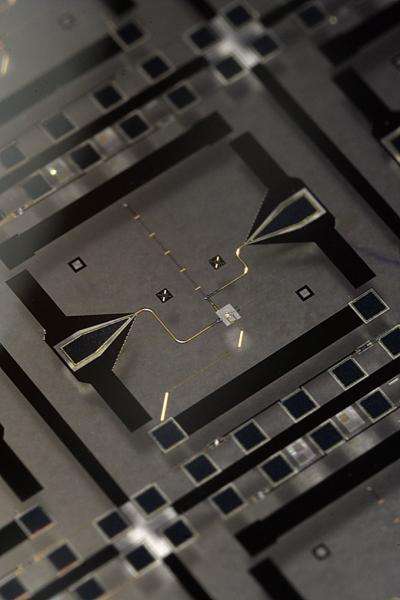 Wired | By using a quantum device to control a mechanical object, researchers have linked the mind-bending laws of quantum physics to the tangible, everyday world.
Wired | By using a quantum device to control a mechanical object, researchers have linked the mind-bending laws of quantum physics to the tangible, everyday world.Until now, quantum physical behaviors were observed at atomic and subatomic scales, or in medium-sized molecules. Now they’ve been found in something that bumps and grinds, visible with nothing fancier than a high school lab-issue microscope.
“At the macroscopic scale we live in, we don’t see quantum effects at all,” said Andrew Cleland, a University of California, Santa Barbara, physicist. “The goal of the experiment was to see if we could see quantum mechanical effects in a large, mechanical object.”
The mechanical object used in the experiment, published March 17 in Nature and led by Cleland and fellow UCSB physicists John Martinis and Aaron O’Connell, is a 0.0002 millimeter-square wafer of quartzlike material bracketed by metal plates. The wafer is a piezoelectric resonator, expanding and contracting in response to electrical voltages at a precise, extremely high frequency. Cleland likened its expansion and contraction to the inflation and deflation of a balloon.
The quantum device is a qubit, a term that generically refers to a kind of quantum transistor being used for quantum computation, in this case made from an ultrathin aluminum-based superconductor. At extremely cold temperatures, it goes quantum: It exists in an oscillating waveform spanning an excited state, an unexcited state, or both simultaneously, all controlled by electrical currents.
With their experiment, the researchers have not only fulfilled a two decade-old dream of controlling quantum motion in micrometer-sized system, but “opened the door for quantum control of truly macroscopic mechanical devices,” wrote Aspelmeyer.
To do so, Cleland’s team wired a qubit to a resonator, then cooled them to a fraction of a degree above absolute zero, the point at which all atomic motion nearly stops. At this temperature, the vibrations of the atoms in the qubit and resonator are small enough to prevent them from interfering with quantum measurements.
When the researchers sent a pulse of energy into the qubit, the resulting energy quantum was transferred to the resonator, which fluctuated accordingly. With extraordinarily acute vision, “you’d see it expanding and contracting. You’d see it vibrating. These are quantum vibrations,” said Cleland.
In a study published in September in Nature, Cleland’s team coupled two qubits in what’s known as quantum entanglement, in which the oscillations of one were linked to the oscillations of the other, even when physically distant. That feat drew attention for demonstrating quantum properties in a large, visible system, but the properties themselves still belonged to electrons, in which quantum effects are routinely observed and controlled.
In a sense, it was the same old quantum physics. The latest results occur in a new world, one that quantum physicists have tried to enter for nearly two decades. In a commentary accompanying the paper, University of Vienna physicist Markus Aspelmeyer described the reaction of an audience of physicists to whom Cleland described the experiment’s design. “Dead silence — and then roaring applause,” he recalled.


0 comments:
Post a Comment